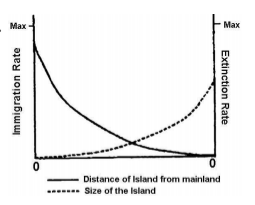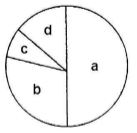 Multiple Choice Questions
Multiple Choice QuestionsFollowing are statements to depict relationship among measures of central tendency in a skewed dataset:
a) In positively skewed datasets, mean > median > mode
(b) In positively skewed datasets, mode > median > mean
(c) In negatively skewed datasets, mean > median > mode
(d) In negatively skewed datasets, mode > median > mean
Which of the above statements are TRUE?
(a) and (b)
(a) and (c)
(b) and (d)
(a) and (b)
Pick the correct statements:
The sky is the blue because Sir C.V Raman gave the correct explanation.
Copernicus believed that the sun, and not the earth, was at the centre of the solar system.
The sky appears blue when seen from the moon.
No solar eclipse is visible for an astronaut standing on the moon.

The above graph illustrates two lines that represent the immigration and extinction rates for an island based on its distance from mainland (solid line) and its size (dotted line). Which of the following is true for this island?
It is close to the mainland and is very small
It is far from mainland and is very large.
It is close to the mainland and is very large.
It is far from the mainland and is very small.
Inclusive fitness of an animal can be measured as a sum of direct fitness and indirect fitness. Imagine you have 10 offsprings. Through diligent parental care, 5 survive to reproduce. You give your life in a heroic deed to save a total of 5 of your nieces and nephews. What is your inclusive fitness?
15
12.5
7.5
3.75
Altruism describes a behaviour performed by animals that may be disadvantageous to self while benefitting others. Which one of the following statements is INCORRECT about altruism?
It is the net gain of direct fitness when sociality is facultative.
It is under positive selection via indirect fitness benefits that exceed direct fitness costs
It generates indirect benefit by enhancing survivorship of kin.
It is favoured when rb – c > 0 where c is fitness cost to altruist, b is fitness benefit to recipient; and r is genetic relatedness.
Following table contains some of the generalization of evolutionary biology:
| Column I | Column II |
| (a) Cope's rule | (i) Population lineages tends to increase in body size over evolutionary time |
| (b) Dollo's law | (ii) There is constant probability of extinction in family of related organisms. |
| (c) Ockham's Principle | (iii) Complex characters, once lost, are not regained |
| (d) van Valen's Law | (iv) Accept the simplest theory that works |
Which of the following is correct match between Column I and II ?
| (a) | (b) | (c) | (d) |
| (i) | (ii) | (iv) | (iii) |
| (a) | (b) | (c) | (d) |
| (i) | (iii) | (iv) | (ii) |
| (a) | (b) | (c) | (d) |
| (ii) | (iii) | (i) | (iv) |
| (a) | (b) | (c) | (d) |
| (iv) | (iii) | (i) | (ii) |
The complexity of a food web in a community is quantified using certain parameters which are defined below. Which of the following is INCORRECT representation?
Given below are some properties related to botanical and zoological nomenclature.
(a) Absence of tautonyms
(b) Presence of genus and species ranks only
(c) Absence of principle of coordination
(d) Presence of only holotype and neotype
Select the correct combination that distinguishes botanical nomenclature from zoological nomenclature system.
(a), (b) and (d)
(a), (b) and (c)
(a) and (c) only
(a), (c) and (d)
Following table gives a list of international environmental agreements and areas covered. Which one of the following is the correct combination?
| Agreement | Area Control |
| (a) Basel convention | (i) Biosafety |
| (b) Cartagena protocol | (ii) Control of trans-boundary movement of hazardous waste and their disposal |
| (c) Kyoto protocol | (iii) Green house gas emission reduction |
| (d) Stockhlom Convention | (iv) Presistent organic pollutants |
| (a) | (b) | (c) | (d) |
| (i) | (ii) | (iv) | (iii) |
| (a) | (b) | (c) | (d) |
| (ii) | (i) | (iii) | (iv) |
| (a) | (b) | (c) | (d) |
| (iv) | (i) | (iii) | (ii) |
| (a) | (b) | (c) | (d) |
| (ii) | (iv) | (iii) | (i) |
The following figure is a “risk-graph” that illustrates the percent risk a species faces towards extinction

The following are ranks assigned according to IUCN’s red-list category:
(i) Critically endangered
(ii) Near threatened
(iii) Vulnerable
(iv) Least concern
Which of the following is the most appropirate match between the percent risk and their assigned rank?
| (a) | (b) | (c) | (d) |
| (i) | (iii) | (iv) | (ii) |
| (a) | (b) | (c) | (d) |
| (i) | (iv) | (iii) | (ii) |
| (a) | (b) | (c) | (d) |
| (iii) | (ii) | (iv) | (i) |
| (a) | (b) | (c) | (d) |
| (iv) | (iii) | (ii) | (i) |
